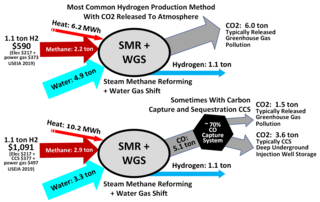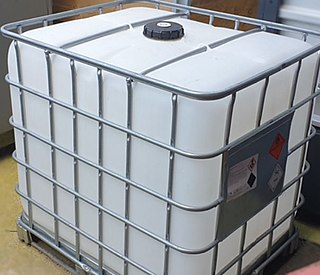
A fuel cell is an electrochemical cell that converts the chemical energy of a fuel and an oxidizing agent into electricity through a pair of redox reactions. Fuel cells are different from most batteries in requiring a continuous source of fuel and oxygen to sustain the chemical reaction, whereas in a battery the chemical energy usually comes from substances that are already present in the battery. Fuel cells can produce electricity continuously for as long as fuel and oxygen are supplied.

A hydrogen vehicle is a vehicle that uses hydrogen fuel for motive power. Hydrogen vehicles include hydrogen-fueled space rockets, as well as ships and aircraft. Power is generated by converting the chemical energy of hydrogen to mechanical energy, either by reacting hydrogen with oxygen in a fuel cell to power electric motors or, less commonly, by burning hydrogen in an internal combustion engine.
Syngas, or synthesis gas, is a mixture of hydrogen and carbon monoxide, in various ratios. The gas often contains some carbon dioxide and methane. It is principally used for producing ammonia or methanol. Syngas is combustible and can be used as a fuel. Historically, it has been used as a replacement for gasoline, when gasoline supply has been limited; for example, wood gas was used to power cars in Europe during WWII.
The hydrogen economy uses hydrogen to decarbonize economic sectors which are hard to electrify, essentially, the "hard-to-abate" sectors such as cement, steel, long-haul transport, etc. In order to phase out fossil fuels and limit climate change, hydrogen can be created from water using renewable sources such as wind and solar, and its combustion only releases water vapor into the atmosphere.
Hydrogen fuel refers to hydrogen which is burned as fuel with oxygen. It can be a zero-carbon fuel, provided that it is created in a process that does not involve carbon. There are many types of hydrogen like green, blue, grey, black, or brown hydrogen owing to the various methods of processes by which they come. It can be used in fuel cells or internal combustion engines. Regarding hydrogen vehicles, hydrogen has begun to be used in commercial fuel cell vehicles such as passenger cars, and has been used in fuel cell buses for many years. It is also used as a fuel for spacecraft propulsion and is being proposed for hydrogen-powered aircraft. The fuel technology has seen awakened interest from automakers who claim it is comparatively cheap and safer to incorporate into the modern vehicle architecture over recent challenges faced by electric vehicle makers.

A fuel cell vehicle (FCV) or fuel cell electric vehicle (FCEV) is an electric vehicle that uses a fuel cell, sometimes in combination with a small battery or supercapacitor, to power its onboard electric motor. Fuel cells in vehicles generate electricity generally using oxygen from the air and compressed hydrogen. Most fuel cell vehicles are classified as zero-emissions vehicles that emit only water and heat. As compared with internal combustion vehicles, hydrogen vehicles centralize pollutants at the site of the hydrogen production, where hydrogen is typically derived from reformed natural gas. Transporting and storing hydrogen may also create pollutants. Fuel cells have been used in various kinds of vehicles including forklifts, especially in indoor applications where their clean emissions are important to air quality, and in space applications. Fuel cells are being developed and tested in trucks, buses, boats, ships, motorcycles and bicycles, among other kinds of vehicles.

Steam reforming or steam methane reforming (SMR) is a method for producing syngas (hydrogen and carbon monoxide) by reaction of hydrocarbons with water. Commonly natural gas is the feedstock. The main purpose of this technology is hydrogen production. The reaction is represented by this equilibrium:

The methanol economy is a suggested future economy in which methanol and dimethyl ether replace fossil fuels as a means of energy storage, ground transportation fuel, and raw material for synthetic hydrocarbons and their products. It offers an alternative to the proposed hydrogen economy or ethanol economy, though these concepts are not exclusive.

A hydrogen station is a storage or filling station for hydrogen fuel. The hydrogen is dispensed by weight. There are two filling pressures in common use: H70 or 700 bar, and the older standard H35 or 350 bar. As of 2021, around 550 filling stations were available worldwide.

The California Fuel Cell Partnership (CaFCP) is a public-private partnership to promote hydrogen vehicles (including cars and buses) in California. It is notable as one of the first initiatives for that purpose undertaken in the United States. The challenge is which come first, hydrogen cars or filling stations.
Hydrogen production is the family of industrial methods for generating hydrogen gas. As of 2020, the majority of hydrogen (∼95%) is produced from fossil fuels by steam reforming of natural gas and other light hydrocarbons, partial oxidation of heavier hydrocarbons, and coal gasification. Other methods of hydrogen production include biomass gasification, methane pyrolysis, and electrolysis of water. Methane pyrolysis and water electrolysis can use any source of electricity including solar power.
Hydrogen technologies are technologies that relate to the production and use of hydrogen as a part hydrogen economy. Hydrogen technologies are applicable for many uses.
A methanol reformer is a device used in chemical engineering, especially in the area of fuel cell technology, which can produce pure hydrogen gas and carbon dioxide by reacting a methanol and water (steam) mixture.
The HyNor-project was a nationally supported project which purpose was to facilitate and coordinate the introduction of hydrogen as a fuel in Norway, running from 2003 to 2012. Toward the commercial introduction of hydrogen vehicles in 2015, the HyNor-project focused on acquiring an early pre-commercial fleet of hydrogen vehicles, and keeping a close dialogue with the leading car manufacturers and other similar initiatives in the Nordic countries and around the world.

Reformed Methanol Fuel Cell (RMFC) or Indirect Methanol Fuel Cell (IMFC) systems are a subcategory of proton-exchange fuel cells where, the fuel, methanol (CH3OH), is reformed, before being fed into the fuel cell.
A hydrogen infrastructure is the infrastructure of hydrogen pipeline transport, points of hydrogen production and hydrogen stations for distribution as well as the sale of hydrogen fuel, and thus a crucial prerequisite before a successful commercialization of automotive fuel cell technology.
Japan's hydrogen highway is a network of hydrogen filling stations placed along roadsides that provide fuel for hydrogen fuel cell vehicles (HFCV). An HFCV is a vehicle that uses a fuel cell to convert hydrogen energy into electrical energy. The hydrogen that is used in fuel cell vehicles can be made using fossil or renewable resources. The hydrogen highway is necessary for HFCVs to be used. HFCV reduce tailpipe emissions of greenhouse gases. By May 2016, there were approximately 80 hydrogen fueling stations in Japan.
The Glossary of fuel cell terms lists the definitions of many terms used within the fuel cell industry. The terms in this fuel cell glossary may be used by fuel cell industry associations, in education material and fuel cell codes and standards to name but a few.
Power-to-gas is a technology that uses electric power to produce a gaseous fuel. When using surplus power from wind generation, the concept is sometimes called windgas.
Green hydrogen (GH2 or GH2) is hydrogen generated by renewable energy or from low-carbon power. Green hydrogen has significantly lower carbon emissions than grey hydrogen, which is primarily produced by steam reforming of natural gas. As of 2021, green hydrogen accounts for less than 0.04% of total hydrogen production. Its cost relative to cheaper hydrogen derived from fossil fuels is the main reason green hydrogen is used less. Green hydrogen may be used to decarbonize sectors which are hard to electrify, such as cement production, and thus help to limit climate change. Green hydrogen can be used to produce green ammonia, the main constituent of synthetic fertilizer. It can also be used for long-duration grid storage of power instead of batteries or pumped-storage hydroelectricity. Hydrogen could be used for seasonal energy storage.








